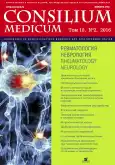The differential diagnosis of neurological disorders in patients with arterial hypertension
- Authors: Vakhnina N.N1
-
Affiliations:
- I.M.Sechenov First Moscow State Medical University of the Ministry of Health of the Russian Federation
- Issue: Vol 18, No 2 (2016)
- Pages: 68-73
- Section: Articles
- URL: https://journals.rcsi.science/2075-1753/article/view/94419
- ID: 94419
Cite item
Full Text
Abstract
Keywords
Full Text
##article.viewOnOriginalSite##About the authors
N. N Vakhnina
I.M.Sechenov First Moscow State Medical University of the Ministry of Health of the Russian Federation
Email: nvakhnina71@mail.ru
канд. мед. наук, доц. каф. нервных болезней и нейрохирургии лечебного фак-та ГБОУ ВПО Первый МГМУ им. И.М.Сеченова 119991, Russian Federation, Moscow, ul. Trubetskaia, d. 8, str. 2
References
- Данные Всемирной Охраны Здоровья. ВОЗ. http://www.who.int/gho/ncd/risk_factors/blood_pressure_text/en/
- Classification and Diagnostic Criteria for Headache Disorders Cranial Neuralgia and facial Pain. Headache Classification Committee of the International Headache Society. Cefalalgia 1988; 8 (7): 1-96.
- Weiss N.S. Relation of high blood pressure to headache episiaxis and seleced other symptoms. N Engl J Med 1972; 287: 631-3.
- Russmussen B.K, Jensen R, Shroll M, Olsen J. Epidemiology of a general population - a prevalence study. J Clin Epidemiol 1991; 44: 1147-57.
- Мамедова З.Д., Фатеева Т.Г., Парфенов В.А. Головные боли у пациентов с артериальной гипертензией и гипертоническими кризами. Неврол. журн. 20134; 2: 28-31.
- Парфенов В.А., Алексеев В.В., Шварева Н.С., Рыжак А.А. Головная боль у больных артериальной гипертонией. Клин. геронтология. 2001; 5, 6: 3-9.
- Парфенов В.А., Замерград М.В., Мельников О.А. Головокружение: диагностика и лечение, распространенные диагностические ошибки. М.: МИА, 2009.
- Толмачева В.А. Причины головокружения. Неврология, нейропсихиатрия, психосоматика. 2010; 4: 18-23.
- Замерград М.В. Головокружение у пациентов с диагнозом дисциркуляторной энцефалопатии. Мед. совет. 2014; 5: 22-6.
- Толмачева В.А., Парфенов В.А. Причины головокружения у пациентов с артериальной гипертензией и его лечение. Врач. 2007; 4: 49-53.
- Skoog I, Lernfelt B, Landahl S et al. 15-year longitudinal study of blood pressure and dementia. Lancet 1996; 347: 1141-5.
- Skoog I. The assotiation between midlife blood pressure levels and late - life cognitive function. Biomed Pharmacotther 1997; 51 (9): 367-75.
- Launer L, Masaki K, Petrovich H et al. The association between midlife blood pressure level and late - life cognitive function. The Honolulu-Asia Aging Study. JAMA 1995; 274 (23): 1846-51.
- Ruitenberg A, Skoog I, Ott A et al. Blood pressure and risk of dementia: results from the Rotterdam study and the Gothenburg H-70 Study. Dementia Geriatr Cogn Disord 2001; 12 (1): 33-9.
- Kivipelto M, Ngandu T, Laatikainen T еt al. Risks corefortheprediction of dementia riskin 20 year samongmiddleaged people: a longitudinal, population - basedstudy. Lancet Neurol 2006; 5 (9): 735-41.
- Старчина Ю.А., Парфенов В.А., Чазова И.Е. и др. Когнитивные расстройства у пациентов с артериальной гипертензией. Журн. неврологии и психиатрии им. С.С.Корсакова. 2008; 4: 19-23.
- Парфенов В.А., Старчина Ю.А. Когнитивные нарушения у пациентов с артериальной гипертензией - начальные проявления сосудистой патологии головного мозга. Неврология, нейропсихиатрия, психосоматика. 2011; 1: 27-33
- Преображенская И.С., Яхно Н.Н. Сосудистые когнитивные нарушения: клинические проявления, диагностика, лечение. Неврол. журн. 2007; 12 (5): 45-50.
- Яхно Н.Н., Захаров В.В., Локшина А.Б. Синдром умеренных когнитивных нарушений при дисциркуляторной энцефалопатии. Журн. неврологии и психиатрии им. С.С.Корсакова. 2005; 105 (2): 13-7.
- Яхно Н.Н., Локшина А.Б., Захаров В.В. Легкие и умеренные когнитивные расстройства при дисциркуляторной энцефалопатии. Неврол. журн. 2004; 2: 30-5.
- Мхитарян Э.А., Преображенская И.С. Болезнь Альцгеймера и цереброваскулярные расстройства. Неврол. журн. (Прил.). 2006; 1: 4-12.
- Смулевич А.Б. Психокардиология и основные аспекты психосоматической медицины // Психиатрия и психофармакотерапия. 2005; 7 (3): 6-9.
- Rosengren A, Hauken S, Ounpuu S et al. Association of psychosocial risk factors with risk of acute myocardial infarction in 11 119 cases and 13 648 controls from 52 countries (the INTER-HEART study): case - control study, www. the lancet.com. September 3, 2004.
- Юдина Н.В., Ишутина Н.П., Раева Т.В. Психические расстройства на начальных стадиях эссенциальной артериальной гипертензии. Мед. наука и образование Урала. 2009; 1: 70-3.
- Смулевич А.Б. Лекции по психосоматике. М.: МИА, 2014; с. 101-14.
- Kanner A.M. Depression in neurological disorders. Lundbec Inst 2005; p. 161.
- Kivipelto M et al. How do heart disease and stroke become risk factors for Alzheimer's disease? Br Med J 2001; 322 (7300): 1447-51.
- Haag M.D, Hofman A, Koudstaal P.J et al. Duration of antihypertensive drug use and risk of dementia: a prospective cohort study. Neurology 2009; 72: 1727-34.
- Perila R, White L.R, Masaki K et al. Reducing the risk of dementia: efficacy of long term treatment of hypertension. Stroke 2006; 37: 1165-70.
- Guo Z, Fratiglioni L, Zhu L et al. Occurrence and progression of dementia in a community population aged 75 years and older: relationship of antihypertensive medication use. Arch Neurol 1999; 56: 991-6.
- Veld B.A, Ruitenberg A, Hofman A et al. Antihypertensive drugs and incidence of dementia in the Rotterdam study. Neurobiol Aging 2001; 22: 407-12.
- Morris M.C, Scherr P.A, Hebert L.E et al. Association of incident Alzheimer’s disease and blood pressure measured from 13 years after diagnosis in the large community study. Arch Neurol 2001; p. 1640-6.
- Чазова И.Е., Ратова Л.Г., Бойцов С.А., Небиеридзе Д.В. Диагностика и лечение артериальной гипертензии. Рекомендации Российского медицинского общества по артериальной гипертензии и Всероссийского научного общества кардиологов. Системные гипертензии. 2010; 7 (3): 5-26.
- Khalil R, Viallet F, Szymanski-Leitaud J. Evaluation psychometrique des effets du Vasobral sur les facteurs structurels de la memoir. Vie Med 1990; 71 (6): 233-40.
- Poncin M, Migeon P, Jamot J et al. Evaluation clinique et psychometrique de L’active du vasobral dans les troubles cognitive du viellissement. Sem Hop Paris 1988; 64 (27): 1839-49.
- Камчатнов П.Р. Результаты применения препарата вазобрал у пациентов с хроническими расстройствами мозгового кровообращения. Журн. неврологии и психиатрии. 2011; 10: 70-2.
- Левин О.С., Баранцевич Е.Р., Бельская Г.Н. и др. Эффективность комбинированного препарата вазобрал при дисциркуляторной энцефалопатии. Журн. неврологии и психиатрии им. С.С.Корсакова. 2014; 10: 25-9.
- Марченко И.В. Эффективность препарата вазобрал у пожилых больных с начальными проявлениями недостаточности мозгового кровообращения и дисциркуляторной энцефалопатией. Новые лекарства и новости фармакотерапии. 2002; с. 19-22.
Supplementary files






